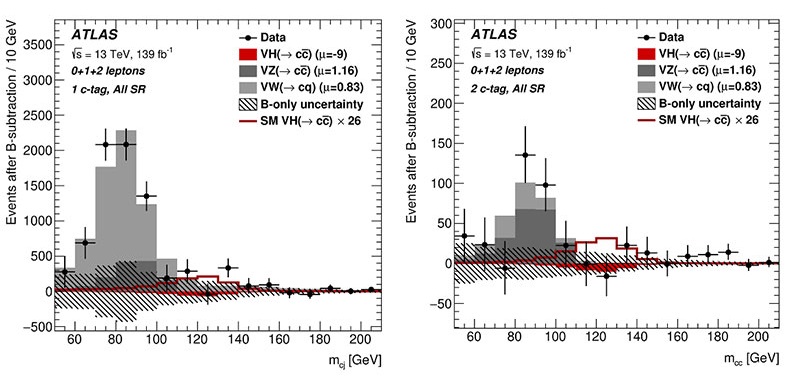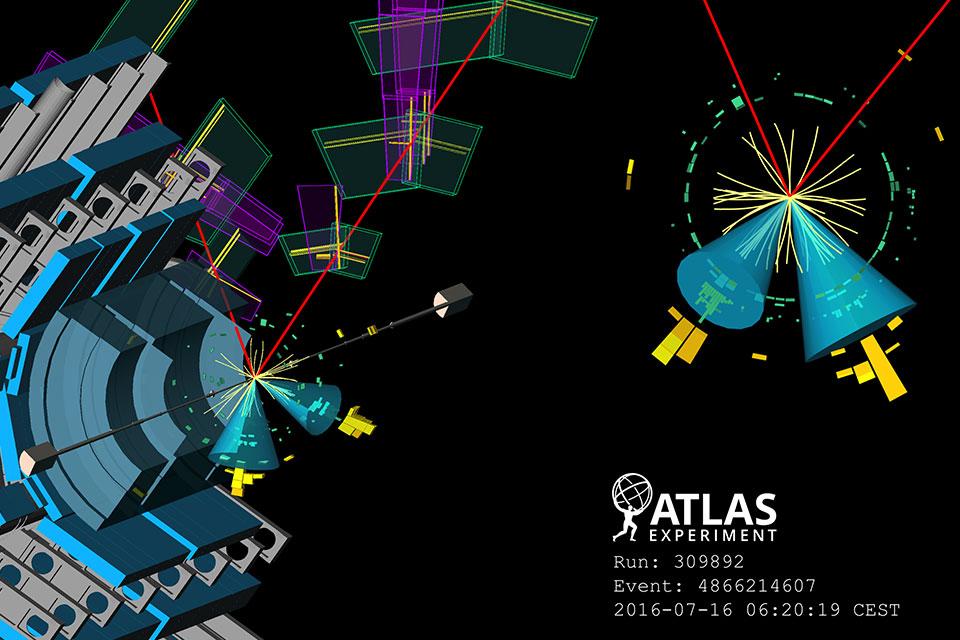Physicists from Cern's ATLAS experiment have been able to probe the Higgs coupling to b- and c-quarks simultaneously using direct Higgs decays – a huge improvement on previous measurements.
All matter particles (‘quarks’ and ‘leptons’) are organised in three generations within the Standard Model. These generations differ by their mass, and particles that belong to higher generations have larger masses. Since the Higgs boson interacts with the matter particles with a strength proportional to their masses, called Yukawa couplings, the Higgs-boson interactions with second-generation quarks should be weaker than those with third-generation quarks. By measuring the Higgs Yukawa couplings in the ATLAS detector, physicists can test the Standard Model and gain new insight into the nature of particle generations.
Recently, the ATLAS collaboration presented a new direct search for Higgs decays into charm quarks. The process is infrequent and accounts for just 3% of Standard Model Higgs decays, and many other processes produce similar signatures in the ATLAS detector. To identify the signal, it is essential to distinguish jets of particles originating from the hadronisation of charm quarks. Researchers used new machine learning techniques to identify the signatures of charm-quarks in the detector by looking for particular properties such as the decay length from the LHC collision point – this is called charm-tagging.
To further suppress backgrounds, physicists searched for Higgs bosons produced in association with a vector boson which decays to electrons, muons or neutrinos – this makes events easier to spot in the ATLAS detector. The researchers also studied events with two vector bosons to validate the analysis strategy, one of which decays into charm quarks. The results of this cross-check agreed with the theoretical expectations and previous precision measurements.

The analysers were able to set a limit on the rate of the decay of the Higgs boson to charm quarks – at 95% confidence level, it is measured to be less than 26 times the Standard Model expectation.
To test the difference between the Higgs Yukawa couplings to the second and third generation directly, ATLAS performed a simultaneous measurement of H->bb and H->cc decays. This measurement combines the H->cc search with a previous measurement of H->bb decays, which also included significant contributions from the Oxford Physics group. The two kinds of Higgs decays look very similar in the ATLAS experiment, with both the b- and c-quarks leaving jets of particles in the detector. This novel combination concludes that the Higgs boson interacts more strongly with b-quarks than c-quarks, as predicted by the Standard Model. The point at which the Higgs coupling to the second and third-generation quarks would be equal is shown as a green line in Figure 3. This point is excluded at the 95% confidence level by the measurement – an important milestone in understanding the interactions of the Higgs boson with second-generation particles.
'This is a huge improvement on our previous measurements, and the first time we can probe the Higgs coupling to b- and c-quarks simultaneously using direct Higgs decays,' explains Oxford DPhil student Maria Mironova, who made significant contributions to the extraction of this result.

Professor Daniela Bortoletto from the University of Oxford commented about the importance of this work: 'One of the mysteries of nature is the existence of three generations of elementary particles with very different masses, which is accommodated in the Standard Model by non-universal Yukawa couplings with the Higgs boson. This limit is an important step to probe the validity of this mechanism.'
The LHC and the ATLAS detector will undergo significant improvements in the coming years to collect even more data, with Oxford involvement in many upgrade areas. With the additional data and ongoing work on improving analyses techniques, researchers hope to understand better the Higgs coupling to the second generation of quarks.
Related links:
https://atlas.cern/updates/briefing/charming-Higgs-decay
https://atlas.cern/updates/briefing/higgs-charm-beauty

